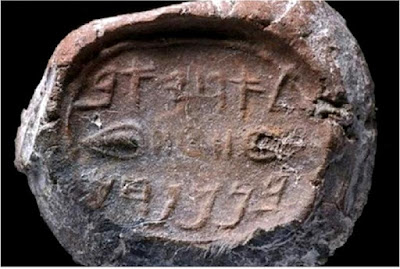DIGGING UP THE BIBLE
Important Archeological Finds that help Us Understand Scripture
pdf
Linda Manuel—1996
Important Archeological Finds that help Us Understand Scripture
Linda Manuel—1996
 |
| Manachem Seal (late 1st century AD) |
While the survival of many seals, which once marked correspondence (since destroyed), have a simple design unique to the author, this particular seal has the name of its author: "Achiav ben [son of] Manachem."
Menachem appears in the biblical text as a monarch from the Northern Kingdom of Israel: "In the thirty-ninth year of Azariah [Uzziah] king of Judah, Menachem...became king of Israel, and he reigned in Samaria ten years. (2 Kgs 15:17). Archav resembles another Israelite king: "Ahab...became king of Israel, and he reigned in Samaria over Israel twenty-two years" (1 Kgs 16:29). Although the seal chronology of these individuals (i.e., Achiav after Manachem) does not match their relative reigns (i.e., Menachem after Ahab), the appearance of these names shows their popularity in Jewish society.
Seals were an important part of official correspondence, helping to ensure the secrecy and integrity of a letter's contents:
Menachem appears in the biblical text as a monarch from the Northern Kingdom of Israel: "In the thirty-ninth year of Azariah [Uzziah] king of Judah, Menachem...became king of Israel, and he reigned in Samaria ten years. (2 Kgs 15:17). Archav resembles another Israelite king: "Ahab...became king of Israel, and he reigned in Samaria over Israel twenty-two years" (1 Kgs 16:29). Although the seal chronology of these individuals (i.e., Achiav after Manachem) does not match their relative reigns (i.e., Menachem after Ahab), the appearance of these names shows their popularity in Jewish society.
Seals were an important part of official correspondence, helping to ensure the secrecy and integrity of a letter's contents:
"[Jezebel] wrote letters in Ahab's name, placed his seal on them, and sent them to the elders and nobles" (1 Kgs 21:8).
This whole vision is nothing but words sealed in a scroll. And if you give the scroll to someone who can read, and say to him, "Read this, please," he will answer, "I can't; it is sealed." (Isa 29:11)
"I took the deed of purchase—the sealed copy containing the terms and conditions, as well as the unsealed copy" (Jer 32:11).
Multiple seals on a single document marked additional security or a document the recipient should open in stages:
I saw in the right hand of him who sat on the throne a scroll with writing on both sides and sealed with seven seals.... The Lamb opened the first of the seven seals. The Lamb opened the second seal.... The Lamb opened the third seal.... The Lamb opened the fourth seal.... He opened the fifth seal.... He opened the sixth seal.... He opened the seventh seal.... (Rev 5:; 6:1,3,5,7,9, 12;8:1)
Significance for Biblical Studies: While the Manachem Seal does not confirm the historicity of any particular king, it shows the popularity of these names and demonstrates how people in 1st century Judaism secured their correspondence.
For a pdf go here.

No comments:
Post a Comment
Relevant and civil comments are welcome. Whether there will be any response depends on whether Dr. Manuel notices them and has the time and inclination to respond or, if not, whether I feel competent to do so.
Jim Skaggs